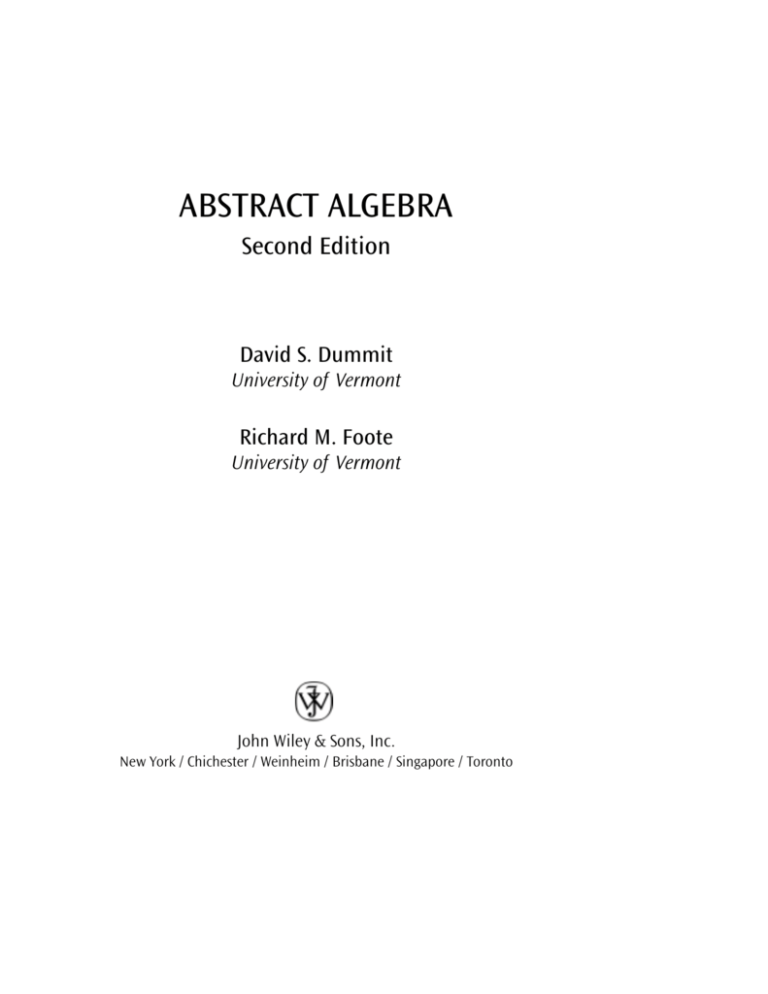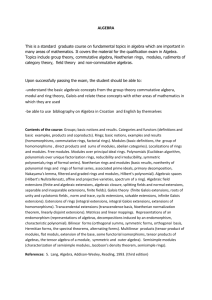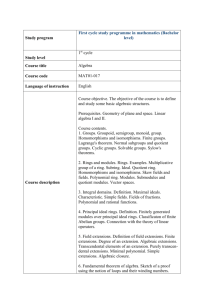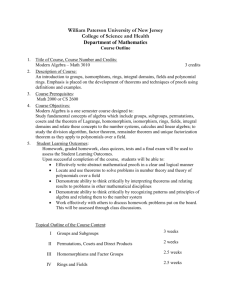
ABSTRACT ALGEBRA
Second Edition
David S. Dummit
University of Vermont
Richard M. Foote
University of Vermont
John Wiley & Sons, Inc.
New York / Chichester / Weinheim / Brisbane / Singapore / Toronto
Cover photo: Rudolf Bauer, “Invention” (Composition 31), 1933. 51 3/8 × 51 3/8
inches (130.5 X 130.5 cms). Solomon R. Guggenheim Museum, New York. Gift, Solomon R.
Guggenheim, 1941. Photo by David Heald. Copyright Solomon R. Guggenheim Foundation, New
York. (FN 41.149)
This book was typeset using the Y&Y TeX System with DVIWindo. The text was set in
Times Roman using MathTime from Y&Y, Inc. Titles were set in OceanSans. Printed and
bound by Quebecor-Fairfield. The cover was printed by Lehigh Press Lithographers, Inc.
The paper in this book was manufactured by a mill whose forest management programs
include sustained yield harvesting of its timberlands. Sustained yield harvesting principles
ensure that the number of trees cut each year does not exceed the amount of new growth.
This book is printed on acid-free paper.
Copyright © 1999 by John Wiley and Sons, Inc. All rights reserved.
No part of this publication may be reproduced, stored in a retrieval system or transmitted in any
form or by any means, electronic, mechanical, photocopying, recording, scanning, or otherwise,
except as permitted under Sections 107 or 108 of the 1976 United States Copyright Act, without
either the prior written permission of the Publisher or authorization through payment of the
appropriate per-copy fee to the Copyright Clearance Center, 222 Rosewood Drive, Danvers, MA
01923, (508) 750-8400, fax (508) 750-4470. Requests to the Publisher for permission should be
addressed to the Permissions Department, John Wiley & Sons, Inc. 605 Third Avenue,
New York, NY 10158-0012, (212) 850-6008, E-mail: PERMREQ@WILEY.COM. To order
books or for customer service call 1-800-CALL-WILEY(225-5945).
Library of Congress Cataloging-in-Publication Data
Dummit, David Steven.
Abstract algebra / David S. Dummit, Richard M. Foote. — 2nd ed.
p.
cm.
Includes index.
II.
ISBN 0-471-36857-1
1. Algebra, Abstract.
Title
QA162.D85 1999
512 0 .02—dc21
I. Foote, Richard M.
Printed in the United States of America.
10 9 8 7 6 5 4 3
98-41445
CIP
Dedicated to our families
especially our wives
Janice and Zsuzsanna
Contents
Preface to the Second Edition
Preface to the First Edition
Preliminaries
0.1
0.2
0.3
xi
xiii
1
Basics 1
Properties of the Integers 4
Z / n Z : The Integers Modulo n
8
Part I – GROUP THEORY
Chapter 1
1.1
1.2
1.3
1.4
1.5
1.6
1.7
Chapter 2
2.1
2.2
2.3
2.4
2.5
Contents
Introduction to Groups
16
Basic Axioms and Examples 16
Dihedral Groups 23
Symmetric Groups 29
Matrix Groups 34
The Quaternion Group 36
Homomorphisms and Isomorphisms
Group Actions 42
Subgroups
13
37
47
Definition and Examples 47
Centralizers and Normalizers, Stabilizers and Kernels
50
Cyclic Groups and Cyclic Subgroups 55
Subgroups Generated by Subsets of a Group 62
The Lattice of Subgroups of a Group 67
v
Chapter 3
3.1
3.2
3.3
3.4
3.5
Chapter 4
4.1
4.2
4.3
4.4
4.5
4.6
Chapter 5
5.1
5.2
5.3
5.4
5.5
Chapter 6
6.1
6.2
6.3
Quotient Groups and Homomorphisms
Definitions and Examples 74
More on Cosets and Lagrange’s Theorem 90
The Isomorphism Theorems 98
Composition Series and the Hölder Program 103
Transpositions and the Alternating Group 108
Group Actions
114
Group Actions and Permutation Representations 114
Groups Acting on Themselves by Left Multiplication—Cayley’s
Theorem 120
Groups Acting on Themselves by Conjugation—The Class
Equation 124
Automorphisms 135
The Sylow Theorems 141
The Simplicity of An 152
Direct and Semidirect Products and Abelian Groups
7.1
7.2
7.3
7.4
7.5
7.6
vi
154
Direct Products 154
The Fundamental Theorem of Finitely Generated Abelian
Groups 160
Table of Groups of Small Order 169
Recognizing Direct Products 171
Semidirect Products 177
Further Topics in Group Theory
190
p-groups, Nilpotent Groups, and Solvable Groups
Applications in Groups of Medium Order 203
A Word on Free Groups 216
Part II – RING THEORY
Chapter 7
74
Introduction to Rings
190
223
224
Basic Definitions and Examples 224
Examples: Polynomial Rings, Matrix Rings, and Group
Rings 234
Ring Homomorphisms an Quotient Rings 240
Properties of Ideals 252
Rings of Fractions 261
The Chinese Remainder Theorem 266
Contents
Chapter 8
Euclidean Domains, Principal Ideal Domains and
Unique Factorization Domains 271
8.1
8.2
8.3
Euclidean Domains 271
Principal Ideal Domains (P.I.D.s) 280
Unique Factorization Domains (U.F.D.s)
Chapter 9
Polynomial Rings
9.1
9.2
9.3
284
296
Definitions and Basic Properties 296
Polynomial Rings over Fields I 300
Polynomial Rings that are Unique Factorization Domains
304
Irreducibility Criteria 308
Polynomial Rings over Fields II 314
9.4
9.5
Part III – MODULES AND VECTOR SPACES
Chapter 10
10.1
10.2
10.3
10.4
10.5
Chapter 11
11.1
11.2
11.3
11.4
11.5
Chapter 12
12.1
12.2
12.3
Contents
Introduction to Module Theory
317
318
Basic Definitions and Examples 318
Quotient Modules and Module Homomorphisms 326
Generation of Modules, Direct Sums, and Free Modules
332
Tensor Products of Modules 339
Exact Sequences—Projective, Injective, and Flat Modules
358
Vector Spaces
388
Definitions and Basic Theory 388
The Matrix of a Linear Transformation 395
Dual Vector Spaces 411
Determinants 415
Tensor Algebras, Symmetric and Exterior Algebras
Modules over Principal Ideal Domains
421
436
The Basic Theory 438
The Rational Canonical Form 452
The Jordan Canonical Form 471
vii
Part IV – FIELD THEORY AND GALOIS THEORY
Chapter 13
13.1
13.2
13.3
13.4
13.5
13.6
Chapter 14
14.1
14.2
14.3
14.4
14.5
14.6
14.7
14.8
14.9
Field Theory
489
490
Basic Theory of Field Extensions 490
Algebraic Extensions 500
Classical Straightedge and Compass Constructions
Splitting Fields and Algebraic Closures 516
Separable and Inseparable Extensions 525
Cyclotomic Polynomials and Extensions 532
Galois Theory
511
538
Basic Definitions 538
The Fundamental Theorem of Galois Theory 547
Finite Fields 565
Composite Extensions and Simple Extensions 571
Cyclotomic Extensions and Abelian Extensions over Q
577
Galois Groups of Polynomials 587
Solvable and Radical Extensions: Insolvability of the Quintic
606
Computation of Galois Groups over Q 621
Transcendental Extensions, Inseparable Extensions, Infinite
Galois Groups 626
Part V – AN INTRODUCTION TO COMMUTATIVE RINGS,
ALGEBRAIC GEOMETRY, AND
HOMOLOGICAL ALGEBRA 636
Chapter 15
15.1
15.2
15.3
15.4
15.5
Chapter 16
16.1
16.2
16.3
viii
Commutative Rings and Algebraic Geometry
637
Noetherian Rings and Affine Algebraic Sets 637
Radicals and Affine Varieties 650
Integral Extensions and Hilbert’s Nullstellensatz 665
Localization 677
The Prime Spectrum of a Ring 697
Artinian Rings, Discrete Valuation Rings, and
Dedekind Domains 716
Artinian Rings 716
Discrete Valuation Rings 721
Dedekind Domains 730
Contents
Chapter 17
17.1
17.2
17.3
17.4
Introduction to Homological Algebra and
Group Cohomology 743
Introduction to Homological Algebra—Ext and Tor
The Cohomology of Groups 764
Crossed Homomorphisms and H 1 (G, A) 780
Group Extensions, Factor Sets and H 2 (G, A) 790
744
Part VI – INTRODUCTION TO THE REPRESENTATION
THEORY OF FINITE GROUPS 805
Chapter 18
18.1
18.2
18.3
Representation Theory and Character Theory
806
Linear Actions and Modules over Group Rings 806
Wedderburn’s Theorem and Some Consequences 820
Character Theory and the Orthogonality Relations 830
Chapter 19
Examples and Applications of Character Theory
846
19.1
19.2
19.3
Characters of Groups of Small Order 846
Theorems of Burnside and Hall 852
Introduction to the Theory of Induced Characters
858
Appendix I:
Cartesian Products and Zorn’s Lemma
Appendix II:
Category Theory
Index
Contents
871
877
885
ix
Preface to the Second Edition
In response to comments from readers of the first edition, this second edition contains a
considerable amount of new material. We have continued to strive to make the material
accessible to undergraduates but increased the scope of topics to make the book more
attractive to graduate students. The emphasis throughout has been to motivate the
introduction and development of important algebraic concepts using as many examples
as possible.
Although the second edition contains substantially more than can normally be
covered in a one year course, the new topics provide significantly greater flexibility
for students and instructors wishing to pursue a number of important areas of modern
algebra. The authors use the text both for the introductory undergraduate algebra course
and also for topics courses at the graduate level.
Material has been added to Chapter 8 and more emphasis has been given to quadratic integer rings, which are introduced in Section 7.1 and developed more thoroughly
through the text. The new sections 10.4 and 11.5 introduce tensor products of modules
and tensor algebras. Section 10.5 discusses extensions, exact sequences and their behavior with respect to the Hom and tensor product functors, topics that are continued in
Chapter 17 with an introduction to the basic notions of homological algebra. Chapter
17 also contains a relatively self-contained treatment of group cohomology. The added
sections in Chapter 10 are at a slightly higher level of difficulty than the remainder of
Chapter 10, and can be deferred on a first reading.
Chapters 15 and 16 are entirely new. These extend the early ring theory chapters
and introduce relations between commutative algebra and geometry. Chapter 15 begins the exposition of some central concepts in commutative algebra and each section
in this chapter is organized so that the abstract algebraic ideas are followed by their
application in algebraic geometry. We focus on affine algebraic spaces, working from
the basic definitions up to the definition of an affine scheme. Chapter 16 continues with
commutative algebra and parallels Chapter 8 in layout, studying three families of rings
(of Krull dimensions 0 and 1), culminating in the classification of finitely generated
modules over Dedekind Domains.
The original chapters on representation theory of finite groups have now been
moved to Part VI and updated in light of the new material now covered in earlier
chapters. Categories and functors appear in Appendix II, not as an add-on but rather to
signal that individuals may read (and reread) this material at almost any point in their
xi
progress through the book. We have purposely minimized the functorial language in
the text in order to keep the presentation as elementary as possible.
The remaining sections of the book are essentially the same as in the first edition,
with the exception of a few added exercises such as ones that incorporate the new material into the old (exercises on tensor products of fields, for example), and an expanded
explanation of some of the subtleties of generators and relations in Section 1.2. In some
instances material that was in the exercises now appears in the text. Instructors may still
offer a standard introduction to abstract algebra, as outlined at the end of the Preface
to the First Edition. Another possibility is to cover the basic material on groups and
rings from Parts I and II, Sections 10.1–10.3, 11.1, and then Chapters 15 and 16. These
latter chapters are, for the most part, independent of Part IV, although basic knowledge
of minimal polynomials and the definition of an algebraically closed field are required
in Sections 15.3 and 15.4; tensor products are used occasionally to simplify proofs but
can be avoided at the expense of some additional labor. Yet another stream is to include
material through all of Chapter 10 and 11.1 followed then by Chapter 17 (which is
essentially independent of the intervening chapters, except for examples involving Galois cohomology). Well integrated one semester courses for students previously having
had some algebra might include Parts III and V, or Parts III and VI. This would provide a solid background for a second semester course delving more deeply into one of
many possible areas: algebraic number theory, algebraic topology, algebraic geometry,
representation theory, Lie groups, etc.
We have chosen the additional material and the style for developing it to reinforce
a basic theme in the book: the power and beauty that accrues from a rich interplay
between different areas of mathematics. We have not attempted to be encyclopedic, but
have tried to touch on many of the central themes in elementary algebra in a manner
suggesting the very natural development of these ideas. As in the first edition, a number
of important ideas appear in the exercises. This is not because they are not significant,
rather because they did not fit easily into the flow of the text but were too important to
leave out entirely. Sequences of exercises on one topic are prefaced with some remarks
and are structured so that they may be read without actually doing the exercises.
We have refrained from providing specific references for additional reading when
there are many fine choices readily available. Also, while we have endeavored to include
as many fundamental topics as possible, we apologize if for reasons of space or personal
taste we have neglected any of the reader’s particular favorites.
We again thank the many students and colleagues who have offered valuable comments on the first edition — it is their support and interest which has energized the
writing of this second edition. We thank George Lobell of Prentice–Hall for his unfailing encouragement and support for the writing of this second edition. We would also
like to thank Ken Brown, David Flath, Donald Passman, and Emma Previato for their
useful comments on this second edition. Finally, we thank Louis Vosloo of Y&Y TeX,
Inc., for his help.
David Dummit
Richard Foote
xii
Preface
Preface to the First Edition
This book evolved out of notes by the authors from courses given at various universities
over a period of about thirteen years. The backgrounds of students in these courses
were quite diverse, ranging from first and second year undergraduates to beginning
graduate students, and included computer science and other science and engineering
majors in addition to mathematics majors. The expectations of the students were quite
varied. For some, the algebra course was to be an introduction with no follow up
(some took only one semester of the full year sequence) and for some the course was
intended to be the foundation for future work in mathematics. We felt that all of these
students should be given some insight into the main themes in abstract algebra and
some understanding of how these themes provide a unifying framework for the study of
the basic algebraic structures: groups, rings, and fields. One of our guiding principles
has therefore been to introduce as early as possible notions such as homomorphisms,
isomorphisms, actions, classifications, and the notion of the structure of an algebraic
object. We point out how these themes recur as we pass from the study of one algebraic
system to another and provide a natural flow for the development of basic abstract
algebra. To a certain extent this has influenced our choice of material as well. We have
made no attempt at being encyclopedic, but rather we have delved more deeply into
a few areas in order that students may achieve a better grasp of how the structure of
algebraic objects is unravelled in greater depth. Wherever possible we have attempted to
broaden students’ horizons by pointing out connections of one subject to other areas of
algebra and mathematics and by mentioning results at the forefront of research. We also
introduce new material in a form which students do not subsequently have to dislodge
in favor of more sophisticated versions. So, for example, permutations are introduced
in cycle notation format and quotients are developed as fibers of homomorphisms.
In this way students are immediately exposed to concepts the way an algebraist (or
mathematician) envisions and works with them.
The book contains a wealth of examples and exercises. The exercises range from
routine computations to fairly sophisticated theoretical ones. All the exercises, however,
are within the scope of the text and hints are given [in brackets] where we felt they
were needed to make them accessible. The main results in the text do not rely on
material in the exercises, although some details in proofs in the text are occasionally
xiii
left to the reader and some examples use results from the exercises. In many instances,
new material is introduced first in the exercises (often a few sections before it appears
in the text) so that students may obtain an easier introduction to it by doing these
exercises (e.g., Lagrange’s Theorem appears in the exercises in Section 1.7 and in the
text in Section 3.2). The exercises also contain a considerable amount of material not
covered in the text. Some exercises lead through a series of steps to new results such
as Wedderburn’s Theorem on finite division rings or Hilbert’s Basis Theorem. There
sometimes appear sequences of exercises on one topic; these problems are prefaced with
some remarks and are structured so that they may be read as text without actually doing
the exercises. Some of these sequences are reviews (such as the exercises on Gauss–
Jordan elimination in Chapter 11) and others contain new material relating to another
area (such as the exercises on the exponential of a matrix and its application to systems
of differential equations in Section 12.3). In addition, a number of exercises describe
useful computational techniques (for example, Berlekamp’s Algorithm for factoring
polynomials mod p in Section 14.3).
Notationally, Proposition 2 in Chapter 4 is referred to simply as Proposition 2 within
Chapter 4 and as Proposition 4.2 in other chapters.
It is not usually possible to cover the entire text in one academic year, although the
authors have been able to cover the bulk of the material in one year, including all of Part
III and much of Part V. A basic introductory (one year) course should include Chapters
1 to 3, Sections 4.1 to 4.3, 5.1 to 5.3, Chapters 7 to 9, Sections 10.1, 11.1 and Chapters
13 and 14, returning to pick up Sections 4.4 to 4.6 if they are not covered initially. Parts
III and V may also be used as a well integrated one semester course. We note that linear
algebra is not assumed to be a prerequisite although knowledge of it does increase the
repertoire of examples in group theory. The basic linear algebra covered in Chapter 11
provides the background mainly for the theory of canonical forms in Chapter 12.
Finally, we would like to thank D. Dorman, H. Kisilevsky, J. Sands, L. Simons and
our students over the past few years for helpful suggestions and comments.
xiv
Preface







